
The beauty of a busy thoroughfare like Lake Street is the history that quietly builds up along its sidewalks. It’s not a museum, perfectly curated for your learning pleasure. It’s living history. Unpolished. Ever changing. You become part of it by just being there. In a couple of blocks you see the immigrant experience that formed the city we are today. Businesses established by first-generation Americans sit side by side. A century-old Scandinavian market operates just down the block from a new Somali/Ethiopian restaurant and a Mexican bakery. There’s no telling how things will change decades from now, but we think you might find a few tasty reasons below to visit these businesses today. In a way, you’d be shaping history. — M.C. Cronin
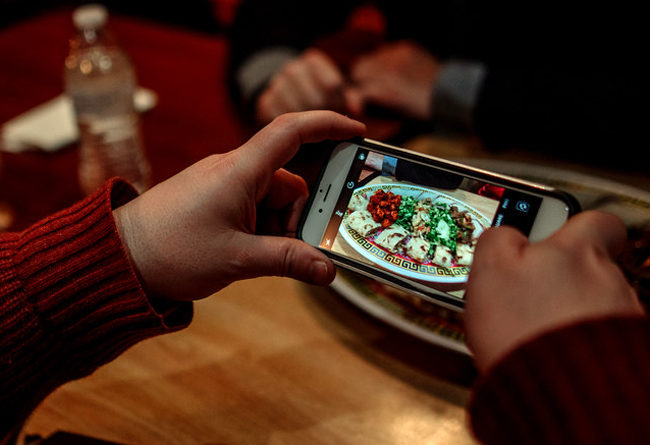
This week’s checklist crew: WACSO, M.C. Cronin, James Norton, Tim McIntosh, Becca Dilley
OTHER EAST LAKE STREET CHECKLIST INSTALLMENTS: Lake Plaza, Gorditas el Gordo to Pineda Tacos, Taqueria Victor Hugo to Safari Restaurant, El Sabor Chuchi to The Rabbit Hole, Midtown Global Market, Miramar to San Miguel Bakery, Mercado Central, Ingebretsen’s to Pasteleria Gama, La Alborada to Quruxlow, Midori’s Floating World to El Nuevo Rodeo, Urban Forage to Himalayan, Blue Moon Coffee Cafe to Merlin’s Rest, Hi Lo Diner to The Bungalow Club

ABOUT THIS PROJECT
The East Lake Checklist is the third Heavy Table illustrated travelogue to explore a major gastronomic thoroughfare in Minneapolis and/or St. Paul. The East Lake Checklist is the Heavy Table’s follow-up to our 55-restaurant survey of independent eateries on Central Avenue and our 72-restaurant series about restaurants on the Green Line. We’ll publish five-restaurant installments biweekly until we’ve documented every nonchain spot on East Lake Street between 35W and the Mississippi River. (We’re estimating 75 spots, but we’ll see how it shakes out.)
This series is made possible by underwriting from Visit Lake Street. Heavy Table retains editorial control of the series — as with Central Avenue and the Green Line, this tour will be warts-and-all.
“From the river to the lakes, visitors and residents can shop local and be social on Lake Street. More information at VisitLakeStreet.com.”
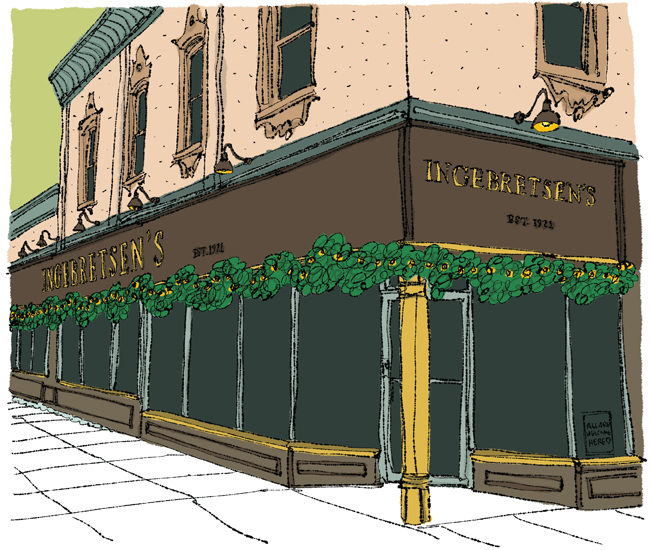
Ingebretsen’s
1601 E Lake St, Minneapolis
It’s hard to imagine East Lake Street without Ingebretsen’s. The place has been slinging Scandinavian specialties like picked herring, Swedish meatballs, and fruktsoppa (fruit soup) on Lake Street since many of our great grandparents were in cloth diapers: 1921 to be exact. So, tradition runs deep here. You can feel it in the wood floors, in the Swedish horses on the gift store shelves, and in the hints of rosemåling you find here and there. You even sense it in the people who work here.

One of the guys behind the counter — we’re pretty sure he was an Ingebretsen — gave us a history lesson. He told us Ingebretsen’s was one of the first delis in the city to get refrigerated glass cases back in the 1930s. An interesting detail made all the more so by the fact that earlier we’d been looking through those very same cases selecting a salmon filet. Those refrigerators have been running for almost 100 years. So, why can’t we buy one that last longer than five years these days?

We visited Ingebretsen’s after the New Year and missed out on the — apparently ridiculous — Christmas rush. “We go from our busiest time of the year to our slowest time of the year almost overnight,” said our friend behind the counter. Traditions run deep. It’s easy to see why this place is so incredibly loved by the families of the Nordic immigrants who helped shape the Twin Cities. — M.C.
*** FOOD NOTES ***
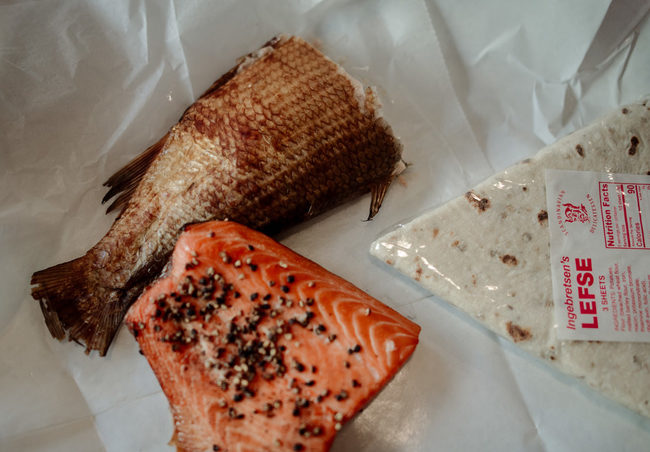
It’s hard to know where to go with a deli spread as wide and varied as the one at Ingebretsen’s (everything from fruit soup to lutefisk to luncheon meats), so we kept it simple: a package of lefse ($7), a half-pound of smoked, pepper-studded salmon ($8.50), and a half-pound of whitefish ($5.50). The lefse was delicate, almost feathery light, and papery thin, with a legit potato flavor through and through.
We thought the salmon was wonderful — evenly smoked with a pronounced (but not acrid or overly aggressive) smoky flavor, a tender, moist texture, and good, evenly distributed hits of black pepper. The whitefish was simple as can be — neutral in flavor with only a hint of smoke, a blank canvas on which to paint other flavors. — James Norton
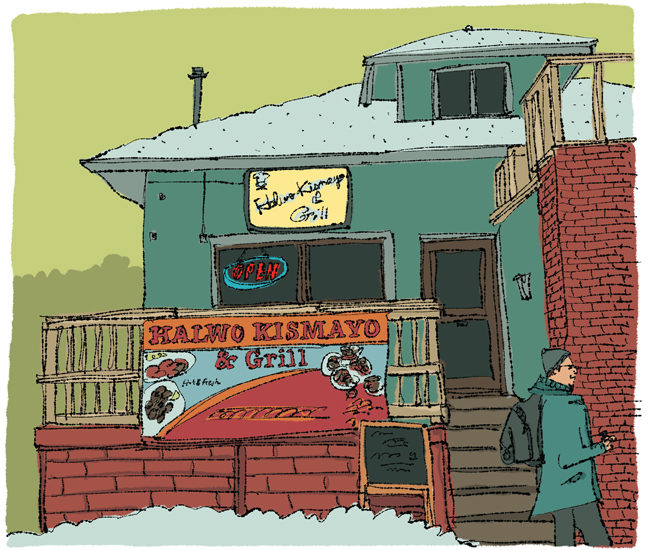
Halwo Kismayo
2937 Bloomington Ave S, Minneapolis
A couple of us spotted this place while parking and peeked into the front window just to make sure it was actually open. Our plan was to go wrangle our full group and return, but a gentleman came out and insisted we come in right away. The patrons gathered in the main room welcomed us with open arms.
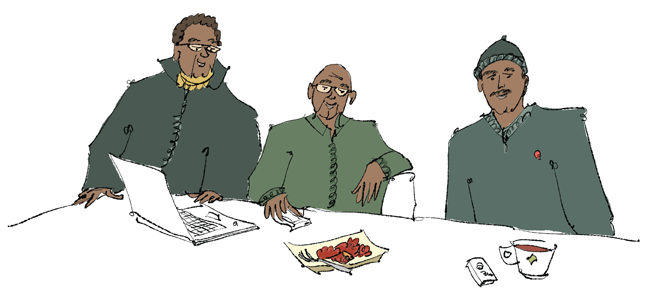
They treated us as friends immediately, happily filling us in on details about the restaurant, smiling and joking with us. They told us the place had been more of a cafe, but it recently reopened with a full kitchen. They said it wasn’t a cheap endeavor, but it was worth it, because, according to the entire group, it has the best sambusas in town. These guys couldn’t have been bigger advocates for the place if they were owners. In fact, if they weren’t owners they should get a commission for the sales job they were throwing down.
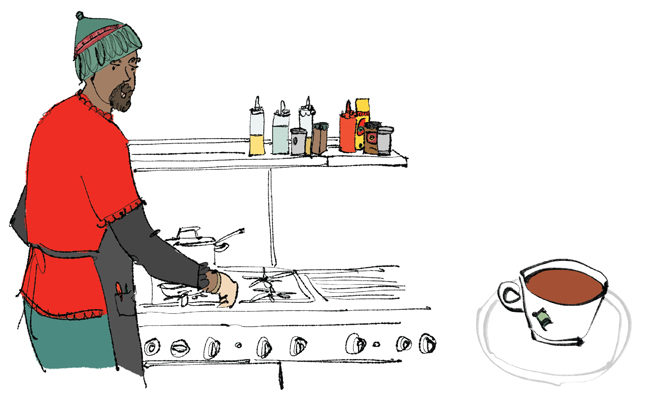
The decor is straightforward. There’s an order counter and a few tables in the front room, and there’s a small room with additional seating in the back. Eventually, the rest of our group joined us and we were seated in the back room.
Unfortunately, the restaurant was out of sambusas, so we’ll have to come back sometime. Something tell us we’d be welcomed. — M.C.
*** FOOD NOTES ***
Owing to WACSO’s talkative nature and curiosity, we found ourselves confronted with a platter of sweets before our meal hit the table. The food that caught WACSO’s eye was the eponymous xalwo (which is part of the greater class of Middle Eastern desserts generally known as halva). We don’t generally lean on the Internet for food knowledge, but this tidbit from the Somali food blog Xawaash.com was too good not to share:
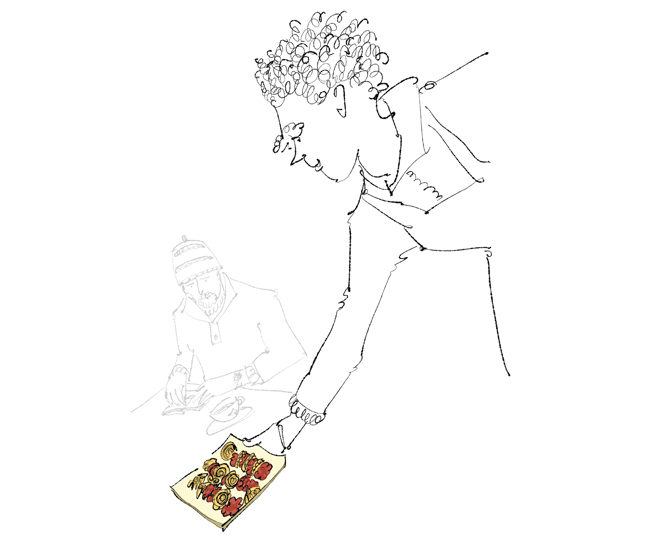
For Somalis, Halwa (Xalwo) is synonymous with festive occasions, particularly weddings. When a Somali says, “Xalwaddeeda ma-cunin,” (lit. “I didn’t eat her halwa”) it means “I didn’t attend her wedding.”

So, it’s a pretty central sweet, even if it’s increasingly enjoyed in day-to-day (as opposed to festive) contexts. The xalwo of Halwo Kismayo was a cluster of rich, assertively rubbery blobs of sweetness, somewhere between a lightly spiced clove-and-cardamom jam and a mildly fruited gummy bear. Spread on the dry butter cookies that came on our plate, the stuff was downright addictive, and we had to check ourselves lest we got completely full on the first plate of the night.
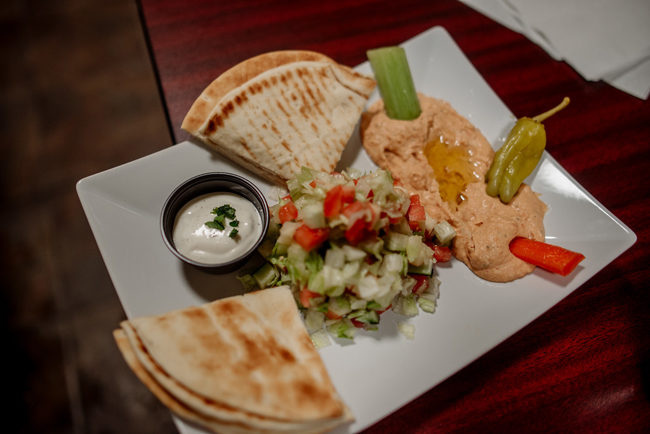
As much as we enjoyed the xalwo, the rest of our food was equally enjoyable, from our massively sweet clove-infused tea to our pillowy, vapor-light, beautifully subtle hummus to our warm, tender triangles of pita.
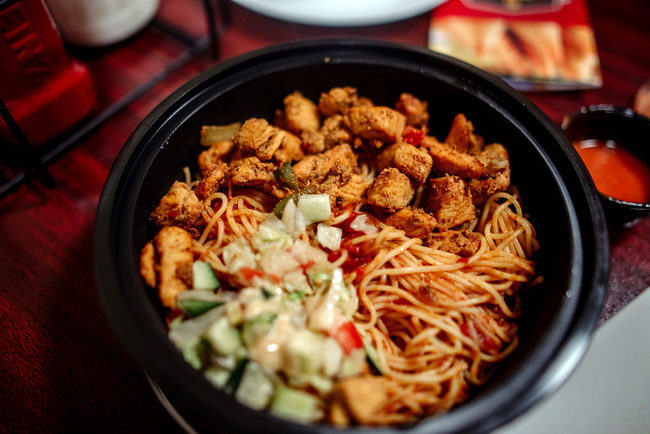
Our chicken shwarma on spaghetti (presented with a side of sauce that was remarkably similar to a Frank’s Red Hot buffalo sauce) was also excellent, the meat tender and deeply seasoned, and the spaghetti perfectly al dente and nicely dressed in a light tomato sauce.
The total cost of our meal was $15. — J.N.
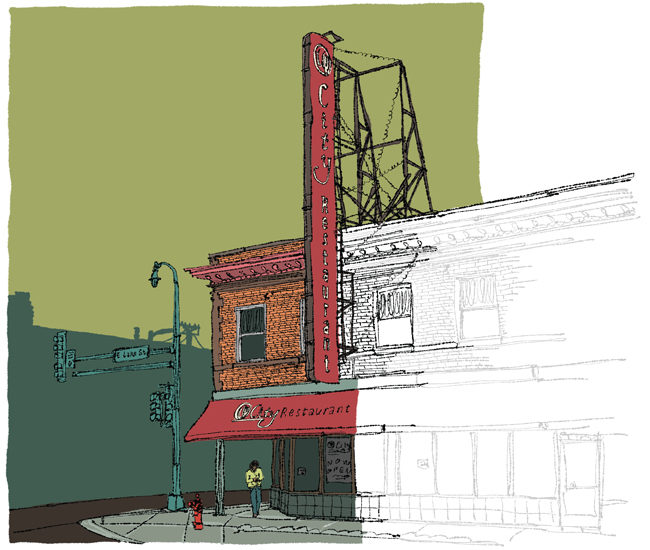
O-City
1526 E Lake St, Minneapolis
We’d attempted to stop in once before. On that night they apologized profusely and told us they’d stopped serving for the evening. A table of ten or so guys were hanging out and the open sign was still on, so the place didn’t appear closed. But the apology seemed sincere, and they happily pointed us in the direction of a Somali restaurant down the block.
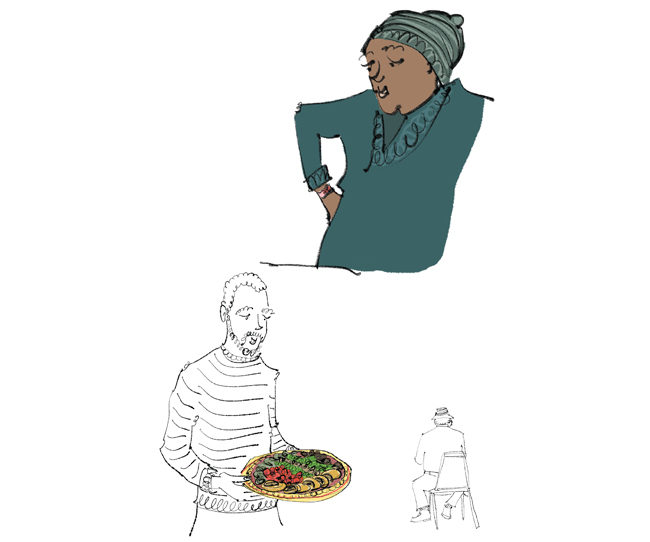
This time though, we were welcomed inside. They even remembered us from a few weeks before. There was another group of guys (or perhaps the same group) gathered around the same table as before. They chatted and watched a soccer match, and a couple of guys even started a game of chess on a fabric board. It felt like a nightly ritual.
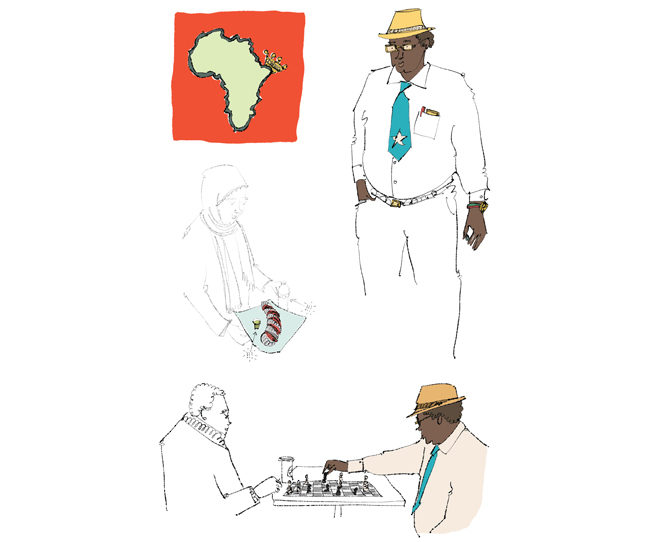
The owner of O-City had a permanent smile and a mischievous sense of humor. When we asked what we should get, he replied, “We have anything you could ever want.” There was a slight pause. “Except beer or pork,” he added dryly before laughing out loud.
We stood at the counter and scanned the menu. The owner’s wife chimed in, “I’ll give you a taste of everything.” The menu had more line items than a corporate tax form, so we hoped she was hyperbolizing.
She wasn’t. The food just kept coming. And our lack of willpower didn’t help. “Just one more bite … OK, that’s it … maybe just one more …”
By the time we walked out, we seriously contemplated quitting for the evening. But we’re a dedicated crew, and our next two stops were bakeries, so we loosened our belts and powered on. — M.C.
*** FOOD NOTES ***

The soup that started our visit to O-City was complicated enough that we could have broken it into three writeups all by itself. First, it was a creamy take on a vegetable soup — deeply (but not overwhelmingly) spicy hot, comforting, but not boring. Second, with the addition of a squeeze of lime, it picked up a beautiful, bright, acid note that changed its character. And third, you can stir in some of the hot, hot, hot spicy green sauce that’s on your table to give it a roaringly fierce kick.
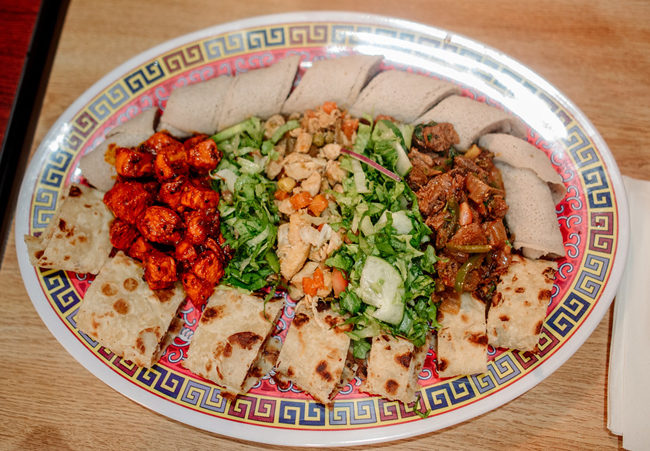
The magnificence of the Sport Platter at O-City ($24) really can’t be summed up with mere words. A photo is necessary to impart its majesty, although it’s best appreciated in person:
So, what are we looking at? Up top: rolls of light, delicate, not-too-sour pieces of injera. To the left: Chili Chicken, every bit as fiery and deeply flavored as you’d hope. In the center: a much milder chicken with a delicate, vinegar-based flavor that was a great match for the shredded lettuce that flanked it. To the right: tender Beef Suqaar. On the bottom: rolled up pieces of crispy, chewy, utterly tasty chapati bread.
While there is some crossover between Somali and Ethiopian food (or Oromo food, to be precise in this case), they’re not the same. The suqaar (which you may know as tibs — sauteed vegetables and tender meat, in this case beef) and injera of O-City hail from the Oromo side of things, and boy were they fantastic.
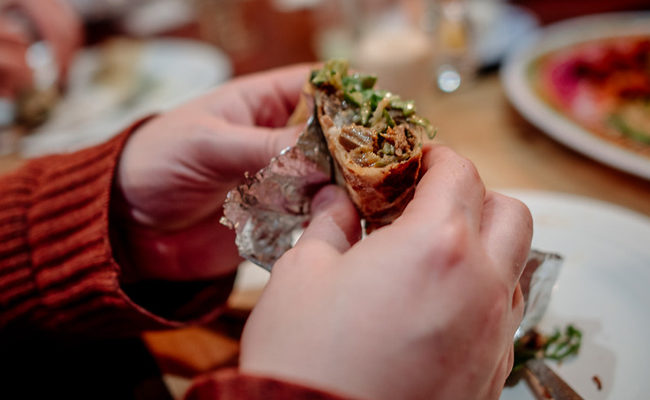
We also tried the Chili Chicken and Suqaar Beef in wrap format ($8), appreciating the burritolike form factor and classic tinfoil wrapping. The Chili Chicken, the rockstar on our platter, was a bit overwhelming in the wrap and needed some more lettuce or dressing to temper its fiery personality. The Beef Suqaar, the quiet understudy on the plate, was utterly delicious in a wrap with just the right ratio of meat to greens to dressing.
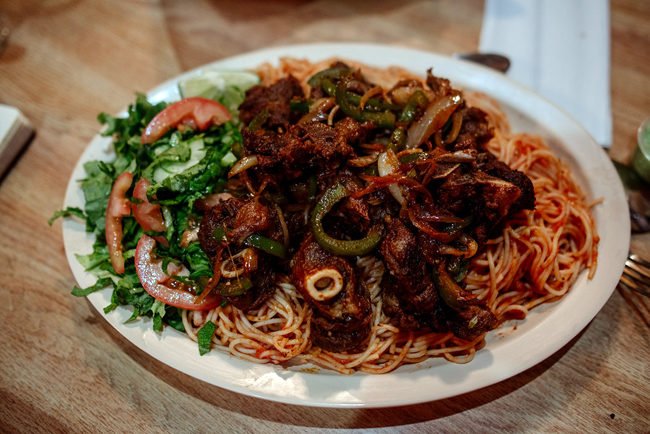
Our plate of stewed goat and spaghetti was the only miss of the meal. The goat fell short of being cooked to tender perfection, and the spaghetti a bit overcooked. — J.N.
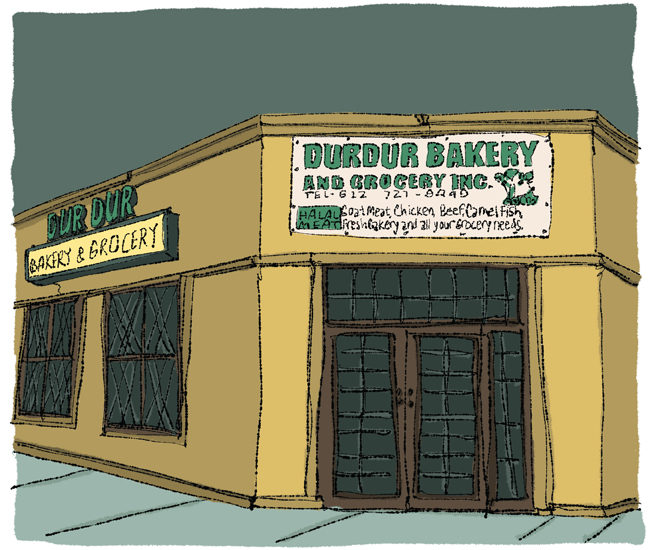
Dur Dur Bakery
1552 E Lake St, Minneapolis
The sign over the door is simple, official, to the point. It tells you that inside Dur Dur Bakery and Grocery Inc. you’ll find halal meats like goat, chicken, beef, camel, and fish along with fresh bakery goods and “all your grocery needs.” And they aren’t kidding. Inside it’s equally utilitarian. There are aisles of specialty grocery items and a meat counter toward the back.
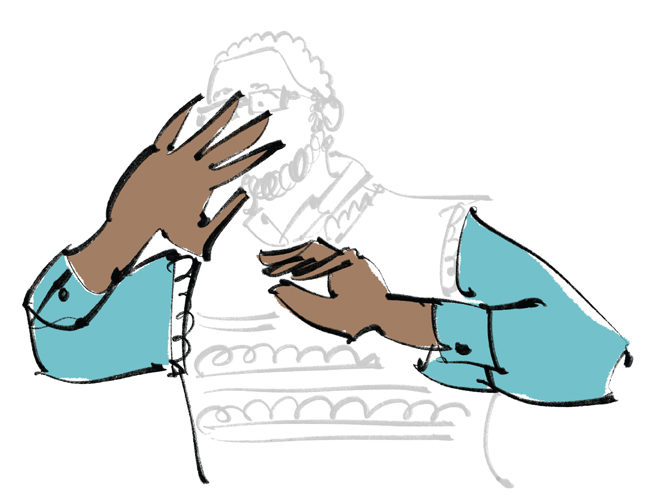
Considering that Dur Dur had bakery in its name, we’d hoped to find some kind of bakery counter, Instead we found only a few racks of baked goods at the front of the store. To be fair, there were breads in all shapes and sizes, from flat to round, packaged in plastic bags with printed labels.
But it was the Ziploc baggies that caught our eye. Nothing says “this could be interesting” quite like Ziploc baggies filled with baked goods. — M.C.
*** FOOD NOTES ***
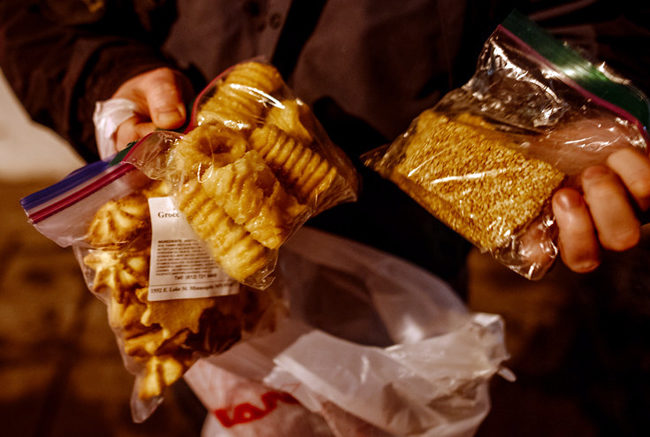
Dur Dur Bakery carries an assortment of baked goods, but only a handful are made in house. They’re easy to pick out with their straight-from-a-bake-sale Ziploc packages and simple, black-and-white, text-only labels.
The butter cookies (or biscuits, or buskud) were simplicity itself, and reminiscent of Italian Christmas cookies (probably not a coincidence, given the colonial relationship between Somalia and Italy.) They were pleasant enough, and would be perfect with coffee or tea or, you know, xalwo, should you happen to have some lying around.
The sesame brittle was fairly close to the stuff we’ve had in the Middle East — toasted, with honey and bitterness in tension to create a real depth of flavor. This was no sugar bomb, and it was about the crunch, first and foremost.
The last item we tried was a fried tube of dough that seemed to be begging for a cream or jelly filling of some sort. By itself it was just a dough pipe of pure neutrality.
Total bill for three bags of baked goods: $6.75. — J.N.
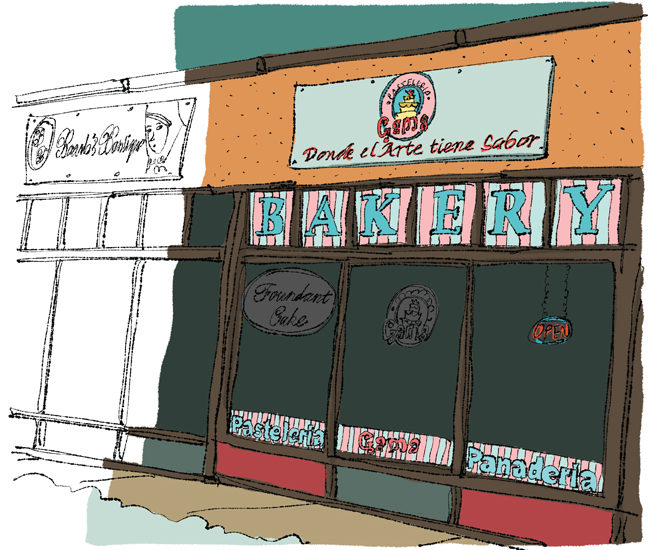
Pasteleria Gama
1703 E Lake St, Minneapolis
The owner of Pasteleria Gama was struggling with a remote control, trying to get the slideshow of his cakes to play on the flat-screen TV overhead. Having had more than our share of A/V challenges over the course of our lives, we felt his pain. Eventually it worked, and we were rewarded with a seemingly endless stream of custom designed cakes.

There was Spiderman, SpongeBob, Bart Simpson, and a multitude of princesses. There was a unicorn-head cake and a workout Barbie cake and a graveyard-themed cake. There were pigs and horses and monkeys and clowns and fruit baskets and flowers and well … you get the idea. To be clear, these weren’t prepackaged cakes or the paint-by-numbers cakes you might order at a big-box grocery store. These had an unmistakably whimsical, handmade quality. If you have an idea for a cake, something tells us the owner of this bakery will find a way to make it.
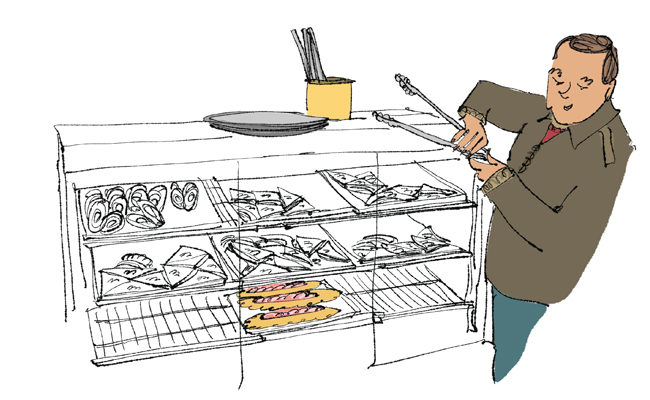
And if any licensing lawyers for Mouse Ears Incorporated are reading this, please turn a blind eye. The world needs more guys who can’t figure out a remote control but will stop at nothing to make a kid smile on his or her birthday. — M.C.
*** FOOD NOTES ***
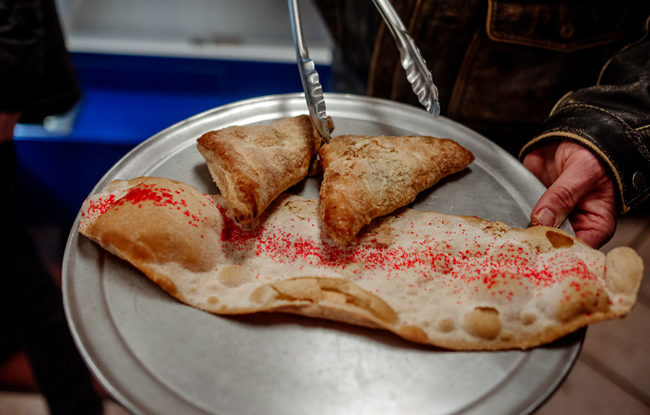
Unlike many Mexican bakeries, Pasteleria Gama presents a visitor with a merely finite variety of choices — a few kinds of cake (pineapple being the house speciality), a few varieties of turnovers, and some strikingly large and light pieces of fried dough called hojas (leaves in Spanish).
Our piña (pineapple) cake was an incredibly simple piece of white cake with a fiercely concentrated layer of pineapple and coconut jam that was enough to make the entire thing taste festive and bright.
We tried a couple of turnovers: the fresa (strawberry) was stuffed with a sweet jam that played nicely off the incredibly flaky, low-key shell. The crema (cream) turnover was a bit of a letdown, as the cream had been mostly absorbed into the pastry, disappearing in the process.
The hoja, a fried sheet of pastry, was little more than pure texture as it wasn’t terribly sweet or flavored with much of anything. But that texture was enjoyable. It was exceedingly crispy and light. — J.N.

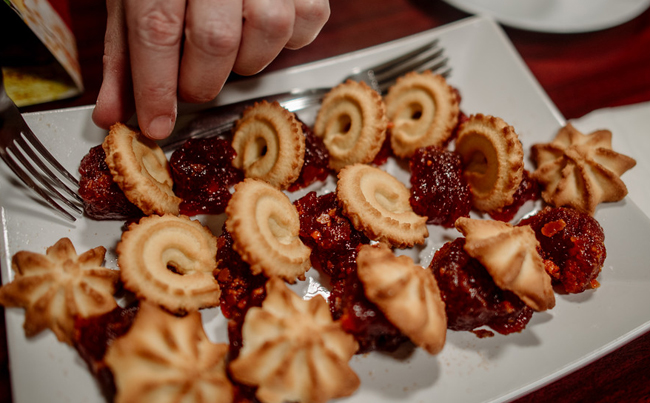

Next time you visit Ingebretsen’s, try the rullepolse, the Norwegian answer to salumi. Try it on crisp bread, maybe with some dill or horseradish Havarti.